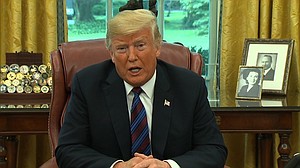10/19/2018

By Samuel G. Freedman
(CNN) -- For a man with too much to say about too many things, President Donald Trump has maintained atypical restraint in the 17 days since since the dissident journalist Jamal Khashoggi disappeared into the Saudi Arabian consulate in Istanbul and was presumably murdered inside it by agents of the regime.
The president groundlessly asserted that "rogue killers" could have committed the crime. Then he retreated even farther to plead that the de facto Saudi dictator, crown prince Mohammed bin Salman, should not be undeservedly suspected in the apparent assassination of a prominent political opponent.
All the president's evasiveness has set off speculation about what conflicted interests might explain it -- Trump's longtime business dealings with wealthy Saudis, his brokering a major arms deal with Riyadh for American defense contractors, bin Salman's importance to American efforts to isolate and confront Iran.
Valid as those theories seem, they omit one other obvious reason for President Trump's striking indifference to the likely slaying of a journalist who was, after all, a resident of the United States for the past several years and a regular columnist for the Washington Post. Quite simply, if a government indeed killed a bothersome journalist, then that action is just the logical, if ghastly, extension of Trump's campaign to vilify and endanger journalists in the United States.
During both his campaign and his White House reign, President Trump has referred to journalists as "disgusting," "crooked," "dangerous," and, most significantly, as "the enemy of the American people." That phrase, closely echoing Josef Stalin's, all but invites the Stalinist solution to such treason: perhaps the show trial, perhaps the Gulag cell, perhaps the executioner's bullet.
With his deviously brilliant demagoguery, President Trump has never explicitly called for the death of American journalists, but he has consistently incited the mobs at his rallies against working journalists, sometimes by name. In her memoir of covering the Trump campaign, "Unbelievable," Katy Tur of NBC recounts Trump pointing out her location to a hostile crowd at a Virginia rally.
"She's back there, little Katy," Tur writes in the book. "She's back there. What a lie it was."
Ostensibly, then-candidate Trump was complaining about a broadcast he considered inaccurate. But no sensate person could miss the mortal threat in his words. Indeed, Secret Service agents walked Tur back to her car after the rally to ensure her safety. At Trump speeches and rallies, journalists are penned in by metal barriers, making them easy prey for heckling and ridicule. Individual correspondents such as April Ryan of the Urban Radio Network, Geoff Bennett of NBC, and Tara Palmeri of ABC have either hired bodyguards at their own expense or received security from their news organization.
Thursday night ,Trump hailed Montana Rep. Greg Gianforte for having body-slammed a reporter -- a crime for which the politician was fined and punished -- during a special election in 2017.
While the fatal shooting last summer of five employees, including four journalists, on the Capital Gazette in Annapolis, Md., had no known roots in Trump's rhetoric, other news organizations have received credible threats that do cite or evoke the presidential hatred.
There is nothing new about political leaders in the United States fuming against journalists for their critical coverage. During his presidency, Richard Nixon put several journalists on his so-called "enemies' list" and dispatched his vice-president, Spiro Agnew, to denounce the news media as "nattering nabobs of negativism."
Nor, sadly, is it unprecedented for an American journalist to be lethally attacked. Just to cite one especially notorious example, Don Bolles, an investigative reporter for the Arizona Republic, was assassinated with a car bomb in 1976.
But even at his most paranoid, Nixon never solicited violence against journalists. And the murder of Bolles, though never fully solved, is widely believed to have been committed by organized crime figures, the target of his reporting.
No, the Trump era has brought a new level of menace, intimidation, and treachery into the mainstream. The Committee to Protect Journalists, sensing the change during the 2016 campaign, began tracking threats and attacks against American journalists soon after Trump took office. Prior to then, the organization was understandably focused on the risks to journalists in unfree nations abroad.
In the old-fashioned world, meaning the one before the Trump presidency, Americans would be right to worry that his feeble response to Jamal Khashoggi's death would embolden autocratic governments or their complicit vigilantes around the world to take similarly brazen action against journalists. And, yes, we should worry about that.
In our upside-down present, however, the concern also holds right here at home, where the president in the MAGA hat defiles the First Amendment, and practitioners of a free press feel ever more the peril that ultimately swallowed up Jamal Khashoggi.
